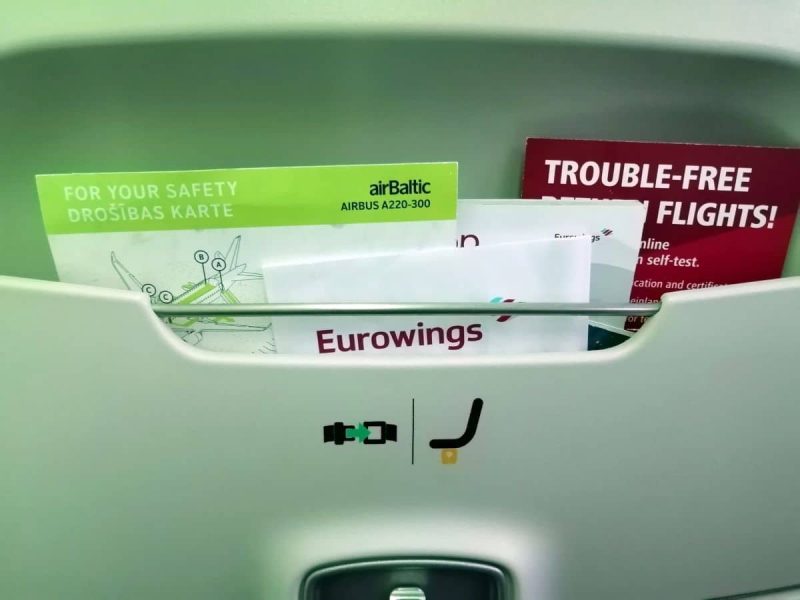Eurowings has had two Airbus A220-300s operated by Air Baltic under contract for a few weeks. These are currently stationed in Stuttgart and are used on numerous routes operated by the Lufthansa subsidiary. In the 2022 summer flight schedule, the Canadian Airbus jets will switch to Düsseldorf Airport.
Eurowings and Air Baltic concluded a long-term wet lease agreement for several Airbus A220s towards the end of last year. As a result, the Latvian carrier is currently flying this type of aircraft from Stuttgart and in the summer from Düsseldorf on behalf of the Lufthansa subsidiary. Unconfirmed rumors even say that Eurowings and its parent company could test the A220-300 extensively in their route networks with the help of the ACMI deal and possibly order identical aircraft themselves.
If another airline, in this case Air Baltic, flies on behalf of the carrier that issued the ticket, there is usually little change for the passengers. The fare provisions and rules of Eurowings continue to apply with this wet lease. Check-in is also done via the Eurowings homepage or app or the check-in counter. Air Baltic is only responsible for the execution of the flight.
Eurowings inflight sales, but otherwise hardly any branding
In the past, Eurowings had CSA under contract from Stuttgart, for example. On the EW flights operated by the Czech airline, there were sometimes free drinks and snacks because there were initially no board sales. This is different with the current Air Baltic wet lease, because the sales catalog is available in the cabin and the flight attendants offer Eurowings products for sale. Trolley and, for example, paper cups are kept in the customer's design.
The screens, security cards and other design features still indicate the carrier. However, there are sick bags, board magazine, sales catalog and advertising for Eurowings corona tests in the seat pockets. The safety cards are expressly those that Air Baltic also uses on commercial flights. There is no special Eurowings branding here.

Eurowings material at Air Baltic (Photo: Jan Gruber). 
Seat bag A220 (Photo: Jan Gruber). 
Seats Airbus A220 (Photo: Jan Gruber). 
Seats Airbus A220 (Photo: Jan Gruber). 
Airbus A220 seat (Photo: Jan Gruber). 
Airbus A220 cabin (Photo: Jan Gruber). 
Air Baltic logo on the seat (Photo: Jan Gruber). 
Air Baltic logo on the seat (Photo: Jan Gruber). 
Airbus A220 wing (photo: Jan Gruber). 
Airbus A220 wing (photo: Jan Gruber). 
Airbus A220 wing (photo: Jan Gruber). 
Screen (Photo: Jan Gruber). 
C Series at the entrance (Photo: Jan Gruber). 
Air Baltic A220 notice (Photo: Jan Gruber). 
Window in the Airbus A220 (Photo: Jan Gruber). 
Seat in the A220 (Photo: Jan Gruber). 
Seat in the A220 (Photo: Jan Gruber).
For legal reasons, some seats are blocked in the front area of the Airbus A220. This is clearly embroidered on the backrests in English. The background is that this type of machine has a few more seats than passengers are allowed to be on board. But that's not a problem, because these serve as a "free next seat" in Business Class. Therefore, the “locked seats” are located in the front part of the cabin. For Air Baltic flights, this is business class and for Eurowings wet lease it is biz class. Class separators were not used during the test flight from Stuttgart to Vienna.
The area subject to a surcharge is located immediately after the "Biz". These seats can only be used when booking eligible fares or by paying a fee.-From about row ten - may vary depending on the route - come, then the normal rows. In terms of the chairs you sit on, however, there is no difference in the entire machine. These are uniform. Airbus A220 seating is: two on the left, three on the right.
Used A220 younger than many Eurowings aircraft
The YL-AAS was in use during the test flight. This is 2,8 years old and was delivered directly to Air Baltic. The Airbus A220s operated by the Latvian airline for Eurowings are significantly younger than many of the client's fleet members. The Canadian medium-haul jet is currently considered state-of-the-art in one segment. Small screens are mounted above each row. The security video, for example, is played on these. In contrast to BT flights, these were deactivated during the flight and were only used again to draw attention to the preparations for landing. The A220 also scores with large windows that offer a good view and spacious luggage compartments. The aisle is wider than, for example, on the Airbus A319, which makes boarding easier. Trolley cases can also be easily pushed through the cabin. For example, on the Boeing 737, it can be observed again and again that passengers get caught on the armrests with their hand luggage. That shouldn't be the case with the A220, but mishaps are generally unavoidable.
The Airbus A220-300 is subjectively perceived to be louder than its direct competitor from Embraer (E2 series), especially in the area of the engines. However, passengers perceive the volume very individually and no measurement was made during the test flight. The washrooms, on the other hand, were not only spacious, but impeccably clean. Various soap and disinfectant dispensers were also available. By the way: The same disinfectant wipes are offered for boarding as on flights operated by Eurowings itself.
The usual welcome and all announcements from the cockpit and cabin crew will be in English. The safety video that is played is the one shown on regular Air Baltic flights and also in English. However, a tape recording in German can be heard afterwards. The crew, who made a friendly and hard-working impression on the test flight, kept the number of announcements to the necessary minimum, which made the flight smooth and relaxed. The crew wears their employer's uniforms, i.e. those of Air Baltic.
Conclusion: Interesting opportunity to get to know the A220-300
Eurowings flight EW2754 was operated by Air Baltic ahead of time and reached its destination, Vienna-Schwechat, around 15 minutes earlier. In contrast to many Eurowings jets of the A320 series, the Wetlease A220 are not equipped with a WLAN system. However, this should not be necessary for most passengers on short flights.
The Air Baltic A220 wet lease with Eurowings is an interesting opportunity to "try out" this aircraft type. Apart from the minimal differences that have been described in the course of this article, there are no significant deviations from flights operated by the Lufthansa subsidiary itself. Since Air Baltic will fly for Eurowings all year round, many passengers will certainly be pleasantly surprised by this type of aircraft and the Latvian state airline. Two A220s are currently in service from Stuttgart and several units of this type are to fly from Düsseldorf for Eurowings in the summer.

Air Baltic A220 notice (Photo: Jan Gruber). 
C Series at the entrance (Photo: Jan Gruber). 
Overhead panel A220 (Photo: Jan Gruber). 
Airbus A220 cabin (Photo: Jan Gruber). 
Seat bag A220 (Photo: Jan Gruber). 
Seats Airbus A220 (Photo: Jan Gruber). 
Airbus A220 cabin (Photo: Jan Gruber). 
Toilet in the A220 (Photo: Jan Gruber). 
Soap and disinfectant (Photo: Jan Gruber). 
Washbasin in the Airbus A220 (Photo: Jan Gruber). 
Air Baltic logo on the seat (Photo: Jan Gruber). 
Air Baltic logo on the seat (Photo: Jan Gruber). 
Air Baltic logo on the seat (Photo: Jan Gruber). 
Window in the Airbus A220 (Photo: Jan Gruber). 
Seat in the A220 (Photo: Jan Gruber). 
Seat in the A220 (Photo: Jan Gruber). 
Airbus A220 seat (Photo: Jan Gruber). 
Seats Airbus A220 (Photo: Jan Gruber). 
Screen (Photo: Jan Gruber). 
Screen (Photo: Jan Gruber).













 trail (for them it's free to use)
trail (for them it's free to use)

3 Comments